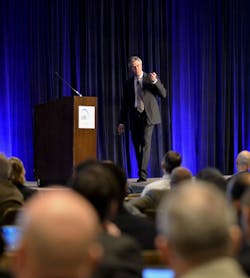It was two years ago that control system suppliers contemplated ExxonMobil’s request for an open process control architecture that is modular, interoperable and scalable. The industry, while squirmish at first, ultimately responded with the formation of the Open Process Automation Forum (OPAF), a consortium under The Open Group comprised of suppliers, integrators, academics and end users—now numbering 132 members. The group set out on a journey to develop a standards-based and secure architecture that could be leveraged across multiple industries, from oil and gas to food, pharma and more.
The group initially outlined four key areas to address. These included an improved understanding of both value-chains and business models, developing a “standard of standards” that would deliver interoperability and application portability, and outlining a conformance program to identify products that comply with the standards created by the forum.
Last year, at the ARC Industry Forum, the group tackled the first deliverable with the publication of the Open Process Automation Business Guide, which outlines the value proposition for the development of such a standard. The business guide addresses common themes across industries with a focus on how companies can use the open process standard to enable best-in-class technologies that minimize downtime, improve safety, reduce engineering hours, and increase both flexibility and speed to market.
This week, at the ARC forum in Orlando, the group launched a preliminary version of its new open process automation standard (O-PAS), vs. 1.0, which specifically addresses the issue of interoperability.
“We are attacking the problems identified by end users in a number of different stages, and the first stage is interoperability” said OPAF director Ed Harrington. “We’ve taken a look at the control stack of the proprietary equipment and software of a small set of DCS vendors to find natural break points in it. Now, we are putting it all together,” he said, noting that version 1.0 will continue to evolve.
As a “preliminary” version, OPAF will solicit feedback from members for about six months. The group is also conducting a supplier “plugfest” in June, which will serve as an interoperability workshop to test the standard. “It’s a week-long test,” Harrington said. “Hopefully we’ll find out what’s good and what’s not so good. We are breaking new ground here.”
Also being tested at the plugfest is ExxonMobil’s O-PAS proof of concept, unveiled last year, which mixed pieces from 10 different vendors’ systems in a fire-heater process. The engineering team did it to prove a point. “We were told some things were impossible and hard to do, so we decided to test it ourselves,” said David DeBari, a process control engineer at ExxonMobil. “We were interested in interoperability because integration is expensive.” They also considered interchangeability as an important impetus behind the effort as control devices and instrumentation have different lifespans, as well as application portability.“We did the proof of concept to show it can be done, and we see the potential benefits.”
As a result, the company is entering a prototype stage. “We’ll take what we learned in the proof of concept and apply it to a pilot unit,” DeBari said. “It’s a process, a small one, but real—with hydrocarbons, it is not simulated. Our goal is to put it in front of the operators.”
O-PAS v. 1.0, is focused on meeting the minimum standard and specification requirements for federated process automation systems, using an open and interoperable reference architecture. A key tenet of the standard is to adopt ‘fit-for-purpose’ industry standards that exist in the marketplace today. As a result, it will incorporate a variety of functional elements that are already provided by multiple vendors, including:
- Security: ANSI/ISA 62443 (adopted by IEC as IEC 62443)
- Connectivity: OPC UA
- Systems Management: Distributed Management Task Force (DMTF) Redfish
“It goes back to the basic philosophy of not reinventing the wheel,” Harrington said. “If standards are out there that we want, we’ll use them.”
Over the next few years, the standard will continue to be updated. Here is a comprehensive list of the technical components that make up O-PAS:
O-PAS Part 1 – Technical Architecture Overview
- An architectural overview of the current release and how it fits with the overall targeted standard
- This part provides an overall perspective of the vision to be attained by the standard
O-PAS Part 2 – Security
- The market has identified the need for security to be built into any new architectural approach to process control systems
- This part, utilizing ANSI/ISA 62443 (adopted by IEC as IEC 62443), forms the basis for compliance with the security requirements of the Open Process Automation Ecosystem
- It provides direction and consistency, from a security perspective, for the development of the other parts, particularly 4 and 5
O-PAS Part 3 – Profiles
- This part specifies the primary profiles for O-PAS conformant components and how they contribute, with version 1.0, to the interoperability required for component connectivity and systems management
O-PAS Part 4 – Connectivity Framework (OCF)
- This part specifies the interfaces necessary to achieve base connectivity for both client-server and publish-subscribe environments
O-PAS Part 5 – System Management
- System management of a process automation system covers a number of different management functions including managing hardware, operating systems and platform software, applications, and networks
- The scope of part 5 of the O-PAS standard v1.0, addresses hardware management only
- Future versions will address the other system management functions
A new version is expected to roll out every year. When it’s complete, the supplier industry will be impacted, as manufacturers procuring new equipment will be expecting compliance. “Within two to three years we will be saying you need to conform to O-PAS standards,” said ExxonMobil chief engineer Don Bartusiak.
Leaders relevant to this article:

